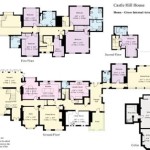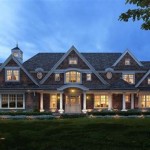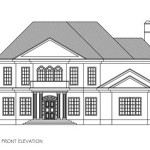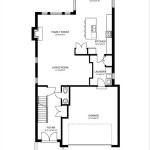Large Ranch House Plans With Basement: Maximizing Space and Functionality
Ranch style homes, characterized by their single-story layout and low-pitched roofs, have long been a popular choice for homeowners seeking ease of living and accessibility. When combined with a basement, the ranch house design offers a significant expansion of usable space, making it an ideal option for families needing extra room for storage, recreation, or living purposes. Large ranch house plans with basements provide a compelling solution for those desiring a spacious, single-level primary living area supplemented by the versatility of a below-grade space. This configuration is particularly advantageous on properties with sloping terrain, where a walk-out basement can seamlessly integrate indoor and outdoor living.
The appeal of a large ranch house plan with a basement extends beyond the sheer square footage. These plans offer a canvas for customization, allowing homeowners to tailor the basement space to their specific needs and preferences. From home theaters and game rooms to in-law suites and home offices, the possibilities are virtually endless. The following delves into the key considerations, benefits, and design elements associated with large ranch house plans featuring basements.
Key Point 1: Advantages of Integrating a Basement into a Large Ranch Design
Incorporating a basement into a large ranch house plan yields a multitude of practical and financial benefits. The most obvious advantage is the increased living area without expanding the footprint of the primary structure. This is especially crucial in areas with zoning restrictions or limited lot sizes. A basement effectively doubles the potential living space, providing ample room for various activities and purposes.
Beyond the added square footage, basements offer exceptional storage capabilities. Unfinished basements can serve as dedicated areas for storing seasonal decorations, tools, equipment, and other items that would otherwise clutter the main living areas. A well-organized basement storage system can significantly enhance the overall functionality and aesthetic appeal of the home.
A finished basement adds substantial value to the property. When designed and constructed to code, a finished basement is considered livable square footage, significantly increasing the home's market value. The return on investment for finishing a basement can be considerable, particularly if the space is designed with popular amenities such as a home theater, extra bedrooms, or a recreational area.
Furthermore, basements provide a natural buffer against temperature fluctuations. The earth surrounding the basement walls helps to regulate the interior temperature, keeping the house cooler in the summer and warmer in the winter. This insulation benefit can translate into lower energy bills and a more comfortable living environment year-round. The inherent thermal mass of the concrete foundation further contributes to energy efficiency.
Finally, basements can serve as safe rooms or storm shelters. In regions prone to severe weather events, a reinforced basement can provide a secure refuge during tornadoes, hurricanes, or other natural disasters. The underground location offers protection from high winds and flying debris, enhancing the safety and security of the occupants.
Key Point 2: Design Considerations for Large Ranch House Plans with Basements
Designing a large ranch house plan with a basement requires careful consideration of several key factors to ensure functionality, livability, and structural integrity. Foundation type, egress options, moisture control, and natural light are all crucial elements that must be addressed during the planning phase.
The type of foundation is a fundamental decision. Common options include poured concrete walls, concrete block walls, and precast concrete panels. Poured concrete is generally considered the strongest and most watertight option, offering superior resistance to moisture penetration. Concrete block walls are a more affordable alternative, but they require careful waterproofing to prevent leaks. Precast concrete panels offer quick installation and consistent quality, but they may be more expensive than other options.
Egress options are essential for safety and code compliance. Building codes typically require basements to have at least one egress window or door that provides a direct escape route to the outside. Egress windows must meet specific size and dimension requirements to allow for easy exit. Walk-out basements, where one or more walls are exposed to the ground level, offer a natural egress point and can significantly enhance the usability and appeal of the basement space. Egress windows should be strategically placed to provide natural light and ventilation.
Moisture control is paramount in basement design. Basements are inherently susceptible to moisture problems due to their underground location. Proper waterproofing, drainage, and ventilation are essential to prevent mold growth, mildew, and structural damage. Exterior waterproofing should include a waterproof membrane applied to the foundation walls, as well as a drainage system to direct water away from the foundation. Interior moisture control measures may include vapor barriers, dehumidifiers, and proper ventilation systems.
Maximizing natural light is a key consideration for creating a livable and inviting basement space. Egress windows, window wells, and strategically placed light fixtures can help to brighten the space and reduce the feeling of being underground. Light wells can be designed to reflect sunlight into the basement windows, further enhancing the natural light. The use of light-colored paint and finishes can also help to brighten the space.
Finally, the layout of the basement should be carefully planned to maximize functionality and flow. Consider the intended use of the space when designing the layout. For example, a home theater may require a large, open area with minimal obstructions, while an in-law suite may require separate bedrooms, bathrooms, and a kitchenette.
Key Point 3: Interior Design and Finishing Options for Basement Spaces
Once the structural elements of the basement are in place, the focus shifts to interior design and finishing. The goal is to create a space that is both functional and aesthetically pleasing, seamlessly integrating with the rest of the home. Flooring, wall finishes, lighting, and overall design style are all important considerations.
Flooring options for basements should be durable, moisture-resistant, and comfortable underfoot. Popular choices include luxury vinyl plank (LVP), engineered hardwood, ceramic tile, and carpet. LVP is a highly durable and waterproof option that mimics the look of hardwood or tile. Engineered hardwood offers the warmth and beauty of real wood, but it is more resistant to moisture than solid hardwood. Ceramic tile is a durable and waterproof option that is ideal for bathrooms and kitchens. Carpet provides a soft and comfortable surface, but it is more susceptible to moisture damage than other options.
Wall finishes should be moisture-resistant and aesthetically pleasing. Drywall is a common choice, but it is important to use moisture-resistant drywall in basements. Other options include wainscoting, paneling, and textured paint. Wainscoting and paneling can add visual interest and texture to the walls, while textured paint can help to conceal imperfections. Consider using light-colored paints and finishes to brighten the space.
Lighting is crucial for creating a welcoming and functional basement space. A combination of ambient, task, and accent lighting is recommended. Recessed lighting provides ambient lighting, while task lighting, such as desk lamps or under-cabinet lighting, provides focused illumination for specific activities. Accent lighting, such as sconces or spotlights, can highlight architectural features or artwork. Natural light should be maximized through the use of egress windows and light wells.
The overall design style of the basement should complement the rest of the home. Whether the style is modern, traditional, or eclectic, the basement should feel like a natural extension of the main living areas. Consider using similar color palettes, furniture styles, and accessories to create a cohesive look. Personalize the space with artwork, photographs, and other decorative items that reflect your personal taste.
Finally, consider the acoustics of the basement when selecting materials and finishes. Basements tend to be echoey, so it is important to incorporate sound-absorbing materials, such as carpets, rugs, and upholstered furniture. Acoustic panels can also be used to reduce noise levels. Proper insulation can also help to dampen sound transmission between the basement and the upper floors.

Versatile Spacious House Plans With Basements Houseplans Blog Com

Ranch Style House Plans With Basement All About Floor

Four Bedroom Ranch House Plan 2207 One Level Plans Family

Sprawling Craftsman Style Ranch House Plan On Walkout Basement 890133ah Architectural Designs Plans

3 7 Bedroom Ranch House Plan 2 4 Baths With Finished Basement Option 187 1149

3 7 Bedroom Ranch House Plan 2 4 Baths With Finished Basement Option 187 1149

House Plans With Basements Dfd Blog

Don Gardner Walkout Basement House Plans Blog Eplans Com

Large Ranch Floor Plans 4000 Square Feet Google Search Basement House Building

Ranch Home 3 Bedrms 5 Baths 2974 Sq Ft Plan 142 1253








